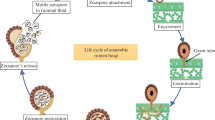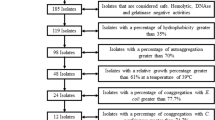Abstract
The objective of this study was to evaluate the aerobic rumen mycobiota from three age groups of Nelore beef cattle reared extensively on lignified pasture. The experiment was randomized and sampled 50 steers, 50 cows, and 50 calves grazed on Brachiaria spp. pasture during the dry season. Rumen fluid in all animals was aromatic, slightly viscous, and greenish-brown in color. Microscopic examination revealed monocentric and polycentric anaerobic fungi in similar proportions (P > 0.05) in the rumen fluid of cows and steers. However, these microorganisms were not identified in any of the samples from calves. In culture exams, aerobic filamentous population was significantly higher for rumen fluid of cows compared to the other two groups. Microculture and rDNA sequence analyses showed Aspergillus spp. as the most frequent aerobic fungus among the isolates from the three bovine groups evaluated. Biochemical profiles were determined by the growth level of yeast isolates with 44 nutrient sources. Ten different yeast profiles were obtained, and yeast isolates from cow ruminal fluid showed ability to catabolize greater diversity of carbon and nitrogen sources. The differences in the fungal populations observed in this study could be explained by microbial and physiological interactions existing in the ruminal ecosystem of each age bovine group. The present study showed the fungal population of the rumen related with differences among age of cattle raised in lignified pastures. Metabolic capabilities of mycelial fungi or yeast identified in this study may be employed in new probiotics or microbial additives for different bovine categories.


Similar content being viewed by others
Abbreviations
- ADF:
-
Acid detergent fiber
- CFU:
-
Colony forming units
- CP:
-
Crude protein
- DM:
-
Dry matter
- EE:
-
Ether extract
- NDF:
-
Neutral detergent fiber
References
Abdalla AL, Silva Filho JC, Godoi AR, Carmo CA, Eduardo JLP (2008) Use of by-products of the biodiesel industry in feeding of ruminants. Rev Bras Zootec 37:258–260
Allison MJ, Reddy CA (1984) Adaptations of gastrointestinal bacteria in response to changes in dietary oxalate and nitrate. In: Klug MJ, Reddy CA (eds) Current perspectives on microbial ecology. American Society for Microbiology, Washington, pp 248–256
Almeida PNM, Duarte ER, Abrao FO, Freitas CES, Geraseev LC, Rosa CA (2012) Aerobic fungi in the rumen fluid from dairy cattle fed different sources of forage. Rev Bras Zootec 41:2336–2342
Altschul SF, Madden TL, Schaffer AA, Zheng Zhang JZ, Miller W, Lipman DJ (1997) Gapped BLAST and PSI–BLAST: a new generation of protein database search programs. Nucleic Acids Res 25:3389–3402
Arcuri PB, Lopes FCF, Carneiro JC (2006) Microbiologia do rúmen. In: Berchielli TT, Pires AV, Oliveira SG (eds) Nutrição de ruminantes. São Paulo, FUNEP, pp 111–150
AOAC (2005) Official methods of analysis of the association analytical chemists, 18th edn. AOAC, Gaithersburg
Carvalho GGP, Pires AJV (2008) Forage plants tissue organization and its implications in ruminant. Arch Zootec 57:13–28
Chaudhry AS (2000) Microscopic studies of structure and ruminal fungal colonization in sheep of wheat straw treated with different alkalis. Anaer 6:155–161
Cuhhingham JG (2008) Tratado de fisiologia veterinária. Elsevier, Rio de Janeiro
Cunha IS, Kruger RH, Quirino BF (2009) Comunicado Técnico 02: Construção de uma biblioteca metagenômica de expressão da microbiota de rúmen de caprinos. Embrapa, Fortaleza
Dantas AF, Pereira-Filho JM, Silva AMA, Santos EM, Souza BB, Cézar MF (2008) Carcass characteristics of Santa Inês sheep finished in grazing and submitted to different levels of supplementation. Ciênc Agrotec 32:1280–1286
De Hoog GS, Guarro J, Figueras MJ, Gené J (2000) Atlas of clinical fungi, Secund edn. Centraalbureau voor Schimmelcultures/The Netherlands and Universitat Rovira i Virgili, Utrecht/Reus
Dirksen G (1993) Sistema digestivo. In: Dirksen G, Grunder HD, Stöber M (eds) Rosenberger: exame clinico dos bovinos, 3rd edn. Guanabara Koogan, Rio de Janeiro, pp 167–169
Edgar Robert C (2004) MUSCLE: multiple sequence alignment with high accuracy and high throughput. Nucleic Acids Res 32(5):1792–1797
Felsenstein J (1985) Confidence limits on phylogenies: an approach using the bootstrap. Evolution 39:783–791
Flipphi M, Sun J, Robellet X, Karaffa L, Fekete E, Zeng AP, Kubicek CP (2009) Biodiversity and evolution of primary carbon metabolism in Aspergillus nidulans and other Aspergillus spp. Fung Gen Biol 46:19–44
Fonty G, Gouet PH (1994) Plant cell wall degradation by anaerobic fungi. In: Prins RA, Stewart CS (eds) Micro–organisms in ruminant nutrition. Nottingham University Press, Nottingham, Dalfsen, pp 97–112
Goes RHTB, Alves DD, Valadares Filho SC, Marson EP (2005) The use of feeding microbial addictive in the feeding of beef and milk cattle.review Arq Ciênc Vet Zool 8:47-56
Gouet FE, Jouany SP (1995) L’écosistème microbien deu réticulo–rumen. In: Gouet FE, Jouany SP (eds) Nutrition des ruminants. INRA editions, Paris
Grenet E, Jamont J, Fonty G, Bernalier A (1989) Kinetics study of the degradation of wheat straw and maize stem by pure cultures of anaerobic fungi observed by scanning electron microscopy. J Anim Sci 2:456–457
Kamra DN (2005) Rumen microbial ecosystem. Curr Sci 89:125–135
Kimura M (1980) A simple method for estimating evolutionary rate of base substitutions through comparative studies of nucleotide sequences. J Mol Evol 16:111–120
Krieg NR, Holt JG (1984) Bergey’s manual of systematic bacteriology. Williams and Wilkins, Baltimore
Kurtzman CP, Fell JW (1998) The yeast: a taxonomic study, 4th edn. Elsevier, Amsterdam
Lacaz CS, Porto E, Martins JEC, Heins-Vaccari EM, Melo NT (2002) Tratado de micologia médica, 9th edn. Savier, São Paulo
Lachance MA, Bowles JM, Starmer WT (1999) Kodamacea kakaduensis and Candida tolerans, two new ascomycetous yeast species from Australian hibiscus flowers. Can J Microbiol 45:172–177
Lund A (1974) Yeasts and moulds in the bovine rumen. J Gen Microbiol 81:453–462
Orskov ER (1995) Optimizing rumen environment for cellulose digestion. In: Wallace RJ, Lahlou-Kassi A (eds) Rumen ecology research planning. International Livestock Research Institute (ILRI), Addis Ababa, pp 177–182
Oyeleke SB, Okusanmi TA (2008) Isolation and characterization of cellulose hydrolysing microorganism from the rumen of ruminants. Afr J Biotechnol 7:1503–1504
Rosa LH, Vaz ABM, Caligiorne RB, Campolina S, Rosa CA (2009) A endophytic fungi associated with the Antarctic grass Deschampsia antarctica desv (Poaceae). Polar Biol 32:161–167
Ruiz-Lacaz R (1992) Microbiologia zootécnica. Roca, São Paulo
Sampaio IBM (1998) Estatística aplicada à experimentação animal, 2nd edn. Fundação de Ensino e Pesquisa em Medicina Veterinária e Zootecnia, Belo Horizonte
Schröder A, Südekum KH (1999) Glycerol as a by-product of biodiesel production in diets for ruminants. In: International Rapeseed Congress, Anais Canberra. Gosford, Australia: Regional Institute, p 241. http://www.regional.org.au/au/gcirc/1/241.html. Accessed 05 May 2011
Sundset MA, Edwards JE, Cheng YF, Senosiain RS, Fraile MN, Northwood KS, Praesteng KE, Glad T, Mathiesen SD, Wright AG (2009) Molecular diversity of the rumen microbiome of Norwegian reindeer on natural summer pasture. Microb Ecol 57:335–348
Tamura K, Nei M (1993) Estimation of the number of nucleotide substitutions in the control region of mitochondrial DNA in humans and chimpanzees. Mol Biol Evol 10:512–526
Tamura K, Peterson D, Peterson N, Stecher G, Nei M, Kumar S (2011) MEGA5: molecular evolutionary genetics analysis using maximum likelihood, evolutionary distance, and maximum parsimony methods. Mol Biol Evol 28:2731–2739
Thareja A, Apuniya AK, Goel G, Nagpal R, SehgaL JP, Singh PK (2006) In vitro degradation of wheat straw by anaerobic fungi from small ruminants. Arch Anim Nutrit 60:412–417
Vries RP, VISSER J (2001) Aspergillus enzymes involved in degradation of plant cell wall polysaccharides. Microbiol Mol Biol Rev 65:497–522
White TJ, Bruns T, Lee S, Taylor J (1990) Amplification and direct sequencing of fungal ribosomal RNA genes for phylogenetics. In: Innis MA, Gelfand DH, Sninsky JJ, White TJ (eds) PCR protocols: a guide to methods and applications. Academic Press, San Diego, pp 315–322
Acknowledgments
This work was supported by CAPES (Coordination of Improvement of Higher Education Personnel), National Council for Scientific and Technological Development (CNPq), Foundation for Research Support of the State of Minas Gerais (FAPEMIG) and Pro-rector of research of the Federal University of Minas Gerais.
Author information
Authors and Affiliations
Corresponding author
Rights and permissions
About this article
Cite this article
Abrão, F.O., Duarte, E.R., Freitas, C.E.S. et al. Characterization of Fungi from Ruminal Fluid of Beef Cattle with Different Ages and Raised in Tropical Lignified Pastures. Curr Microbiol 69, 649–659 (2014). https://doi.org/10.1007/s00284-014-0633-5
Received:
Accepted:
Published:
Issue Date:
DOI: https://doi.org/10.1007/s00284-014-0633-5




